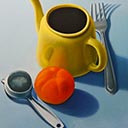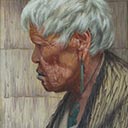Strainer, Tangelo, Teapot, Fork
72 x 61.5 cm
est. $25,000 - 35,000
Provenance:
Dr Allan Godfrey Collection
Purchased from Canterbury Gallery, Christchurch. Gallery stamp verso
This still-life by Michael Smither belongs to a distinct period in the artist's work when his paintings assumed an introspective quality. Fuelled by the harmonious potential of domestic subject matter, Smither instilled these works of the early 1990s with an almost imperceptible, but certainly meditative energy. The title, Strainer, Tangelo, Teapot, Fork accurately reflects the poetic simplicity and harmonious exchange through which simple domestic items have been afforded an aesthetic and artistic weightiness.
Herein, scale, light and composition contribute to a hyperrealism of four objects, likely assembled from Smither's own kitchen, which have been imbued with a luminary radiance and beauty. A single source of natural light is implied from the left hand side, casting dramatic shadows of an almost broody nature. Smither has accomplished this with great finesse, whilst at the same time manipulating light to delicately cast the reflection of the strainer and tangelo against the surface of the teapot.
This effect is heightened by the subtle and clever layers of contrast in the work: just as the repetitious rounded forms of the teapot, strainer and tangelo are offset by the linear elegance of the fork, the warm tones of the tangelo and teapot coolly exist within the tonal enclosures of the grey strainer and fork.
Unassuming in its form and composition, there is a theatricality to this work which converges with the casual simplicity of both subject matter and arrangement. This theatrical quality, however, should not be conflated with the classical remit of still-life painting. For, whilst the tradition of still-life painting is one whose rich history is supercharged with symbolism (the most art historically significant example being that of 17th century Dutch still-life works and memento mori), Smither's still-life does not serve to present a display of objects for collective symbolic and moral consideration, but rather to construct a metaphysical interchange of form, light and energy.





